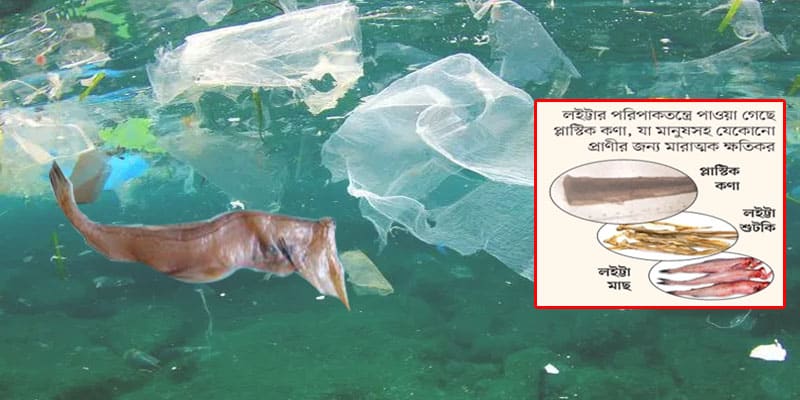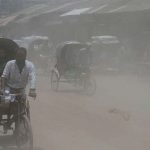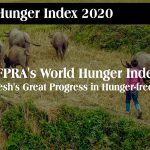Harmful plastic in the fish stomach in the Bay of Bengal, Human health at risk
By Adnan Mahfuz
Plastic particles are extremely harmful material for the human body. It causes various diseases in the human body. According to health experts, plastic particles are harmful not only to humans but also to any animal.
This artificial ingredient can cause various diseases, including cancer, respiratory problems, digestive problems, which, if entered into the body with regular food; people are at risk of contracting more diseases.
Recently, four researchers from Chittagong University and Shahjalal University of Science and Technology found plastic particles with food in the stomach of Liotta fish (Bombay duck) extracted from the Bay of Bengal.
This harmful substance has also been found in the bodies of marine fish, sardines and shrimp. The research team even found plastic particles in the stomachs of marine green snails and crabs.
There is a lot of demand for dried fish in the country. Especially Liotta shuntaki (Dried Bombay duck) is most in demand. The coast of Cox’s Bazar produces dried fishes about the worth of Taka 3 billion a year. And one-third of it is Loitta Shutaki (Dried Bombay fish).
According to the research conducted, a dangerous message was given by Loitta that the presence of plastic particles in all other fishes bodies in the Bay of Bengal. Currently, the perfect season of Loitta fish has started. Fishers are extracting Loitta from the Bay of Bengal.
Most of which are going to dry processing factories. And when this fish is dried, its stomach and digestive system are not cut. Due to which it turns into the dry matter along with plastic particles. And then it enters into the human body with food.
Earlier this year, the study on Loitta (Bombay fish) and Sardine was published in the journal Science of the Total Environment. The study on shrimp was published in the international science journal the Chemosphere. The other two studies are awaiting publication.
According to the two published studies, samples of Loitta (Bombay fish), Shrimp, and Sardines were collected from different North Bay places. About 300 fish samples were collected and cut and tested in the laboratory of the Institute of Marine Sciences and Environment Department of Chittagong University. All of them contain plastic particles.
Study of 6 types of plastic particles
The study found six types of plastic particles. Searching for the source, the team found that the plastic particles came mainly from polyester fishing nets, cork sheets, food packets and polythene, water bottles, and furniture.
They have fallen from the river to the sea. They are being broken into small particles by the waves mixed with animal and plant particles. And fish and marine animals are eating it, thinking it is food. Eating plastic particles causes various problems in the body of fish and decreases the digestion of fish.
Its growth is disrupted. The research team is now working on whether other large fish in the Bay of Bengal have plastic.
Shahadat Hossain, a member of the research team and Professor of the Institute of Marine Sciences, University of Chattagram, said, “Plastic particles are being seen as one of the most harmful elements for the future in different countries of the world.” We need to be more careful when using plastic. Because it is going around and entering our bodies.”
Subrata Sarkar, another member of the research team and an Assistant Professor at Shahjalal University of Science and Technology, said: Most of them we eat, we export. So, first of all, we have to stop throwing plastic in rivers and seas. The government has to be strict in this regard.
According to the research team, plastic particles are also found in fish and other organic matter, which has been found in fish extracted from the coasts of several countries in the world, including Japan, Norway, Sweden, and Mexico.
But there was no research on this subject in Bangladesh for so long. Although several studies have been started from Bangladesh Fisheries Research Institute and Bangladesh Agricultural University, they are not completed.
Asked about the government’s initiatives to control harmful plastic particles, AKM Rafiq Ahmed, Director General of the Department of Environment, said, “We have taken various initiatives to control the use of plastics in the country as a whole.”
We are working to ensure that plastic materials used for various purposes, including product packaging, are not thrown away and collected to be recycled. We are advising the manufacturing companies of these products to cooperate in this work. ‘
Sharif Uddin, Chief Scientific Officer of the Marine Fisheries Survey Management Unit of the government, said, ‘We are surveying the quantity and type of marine fish. So we have to be careful so that tiny plastic particles do not get into the fish there.
The concerned people should be responsible so that the fishermen do not take the plastic material by boat, and the plastic material is not thrown into the sea from the ship.



